Snagging lobster pots & a DIY hookah solution, cordless compressor update

With winter setting in fast, it’s nice to remember summer, even a cruising hassle like snarling lobster trap gear around Gizmo’s running gear. During my 48 years in Maine waters, the catch has increased from 20 to 120 million pounds and the pot buoy systems have gotten significantly tougher; so snagging one has become much more of a hazard. But the grin above is not just because I’d finally cut away this particular mess; I think I’ve found a reliable snarl solution that will even work out in the remote Maine islands that lobsters, lobstermen, and cruisers all appreciate.
I’m fully aware that cutting a lobster pot buoy line costs the fisherman owner serious money — this article explains the tricky situation well — and we try hard to avoid them. And that’s fairly easy to do because Gizmo’s bow wave tends to push buoys away while the keel extension to the rudder foot makes it hard for lines to get up near the wheel. (I also know a little about the many lobster pot gear configurations, and how the various main, toggle, and/or wash buoy lines can lay in differing wind and tidal current situations.)
On the other hand, that 28 x 28-inch four-bladed prop can quickly create a terrible tangle that’s darn hard to clear with only a snorkel — let alone a boat hook, or even a “wickedly effective” hook knife — and an early Gizmo upgrade was the install of a shaft cutter similar to what’s carried by most inboard vessels around here, including many lobster boats. It’s not a complete solution, however, as I’ll explain along with some sweet summer memories, good monitoring/tracking included.
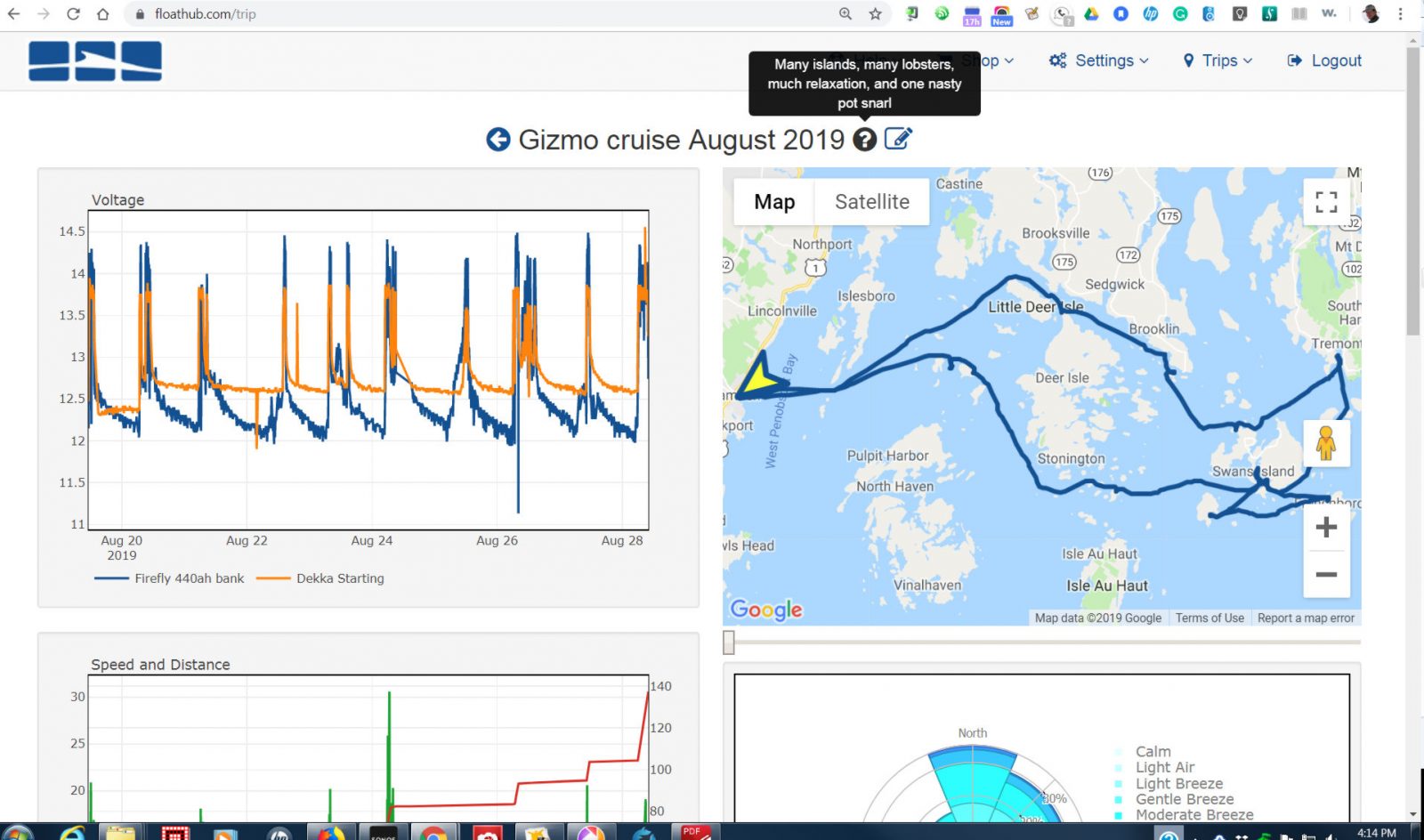
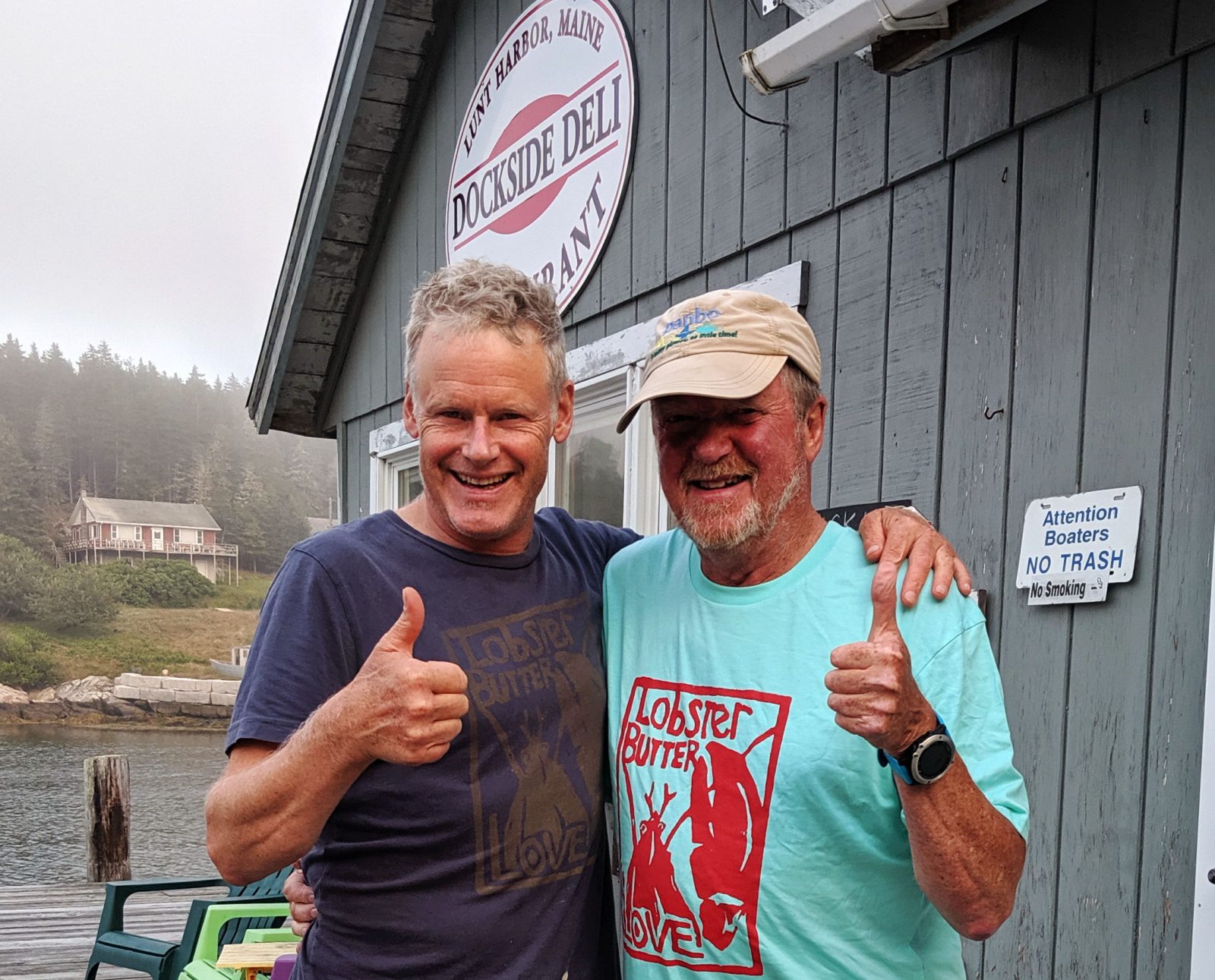
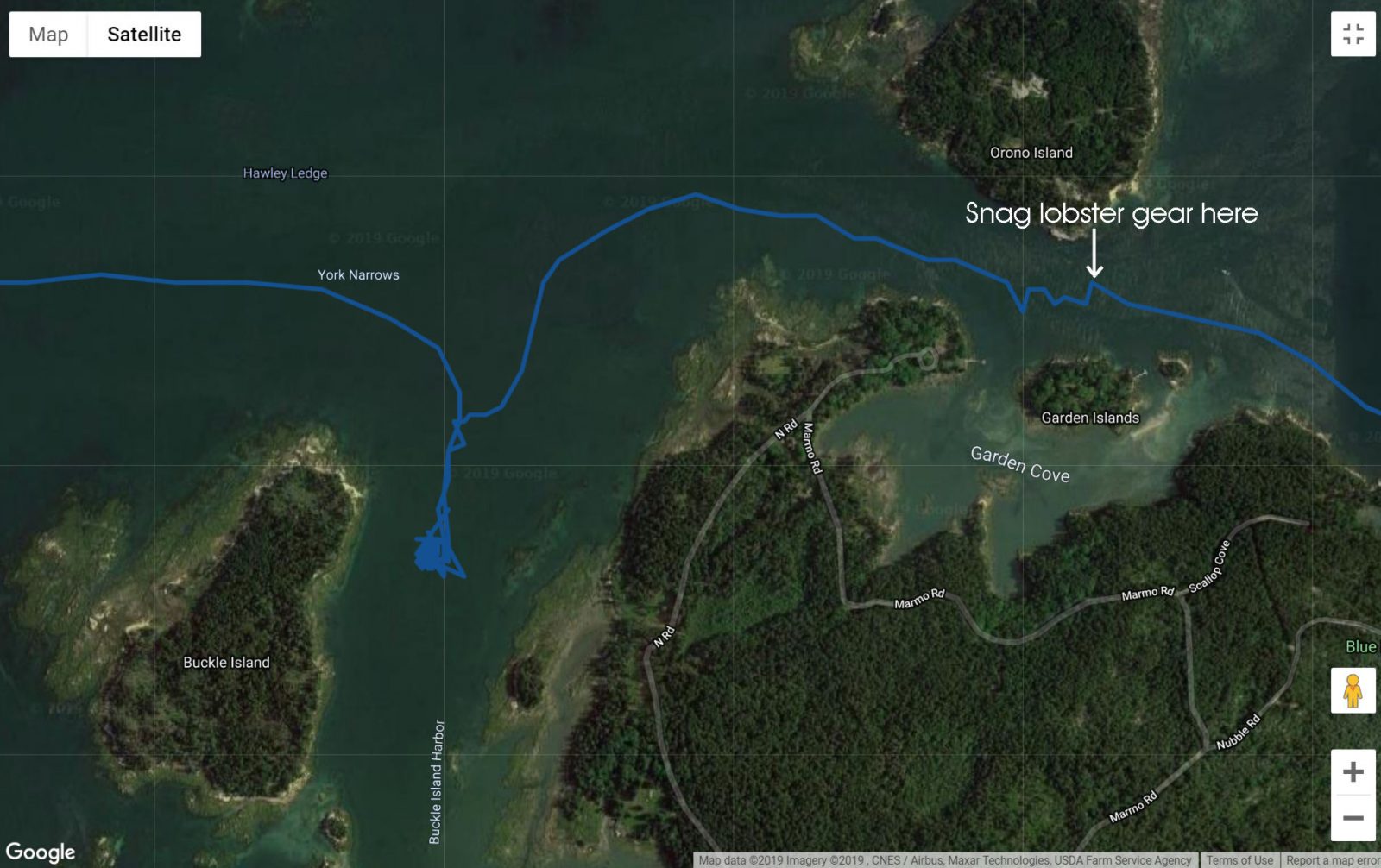
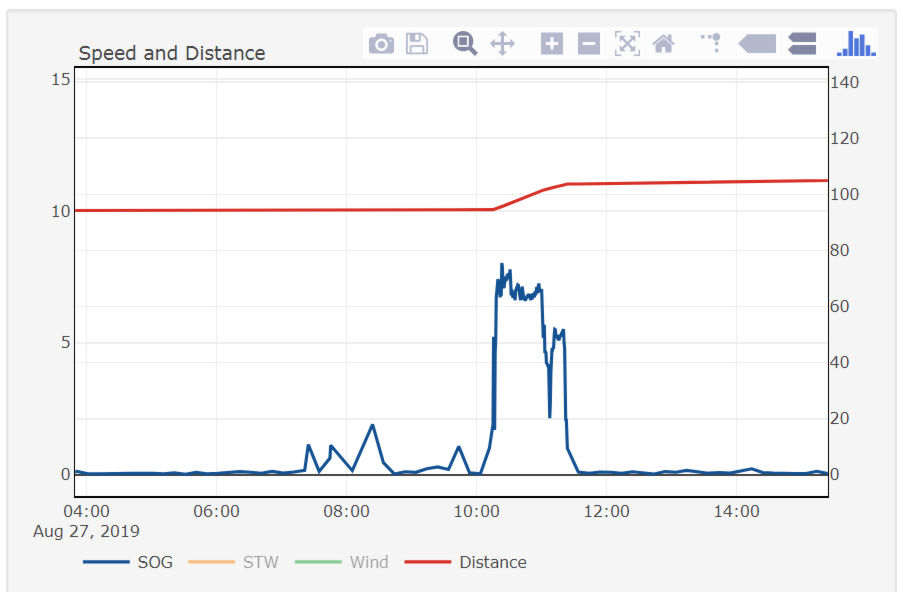
The inexpensive FloatHub monitoring system I’ve been long testing can now automatically identify underway activity and create neat Trip web pages (even when it’s offline during much of the trip). So I have a detailed track map (upper-left) along with all sorts of other data to remind me of a classic August meander around the midcoast bays with many islands hiked and several very fresh lobsters eaten.
A highlight this year was finding always-pleasing Lunt’s Dockside Deli (moorings and WiFi too) being exuberantly managed by John Roos, who — despite being an “away” person mostly from Ann Arbor, Michigan — is also the creator of the excellent coffee roast Lobster Butter Love. Stranger things happen, but not often enough.
I might have been wearing my favorite new tee shirt a few days later when the cruise went amok in a narrow passage on the north side of Swans Island. We were going slow — about 7.5 knots according to the FloatHub record, which reduces the “push away” effect — but I was on the flybridge with excellent visibility and I’m pretty sure the pot buoy line we snagged was hung down below the water surface.
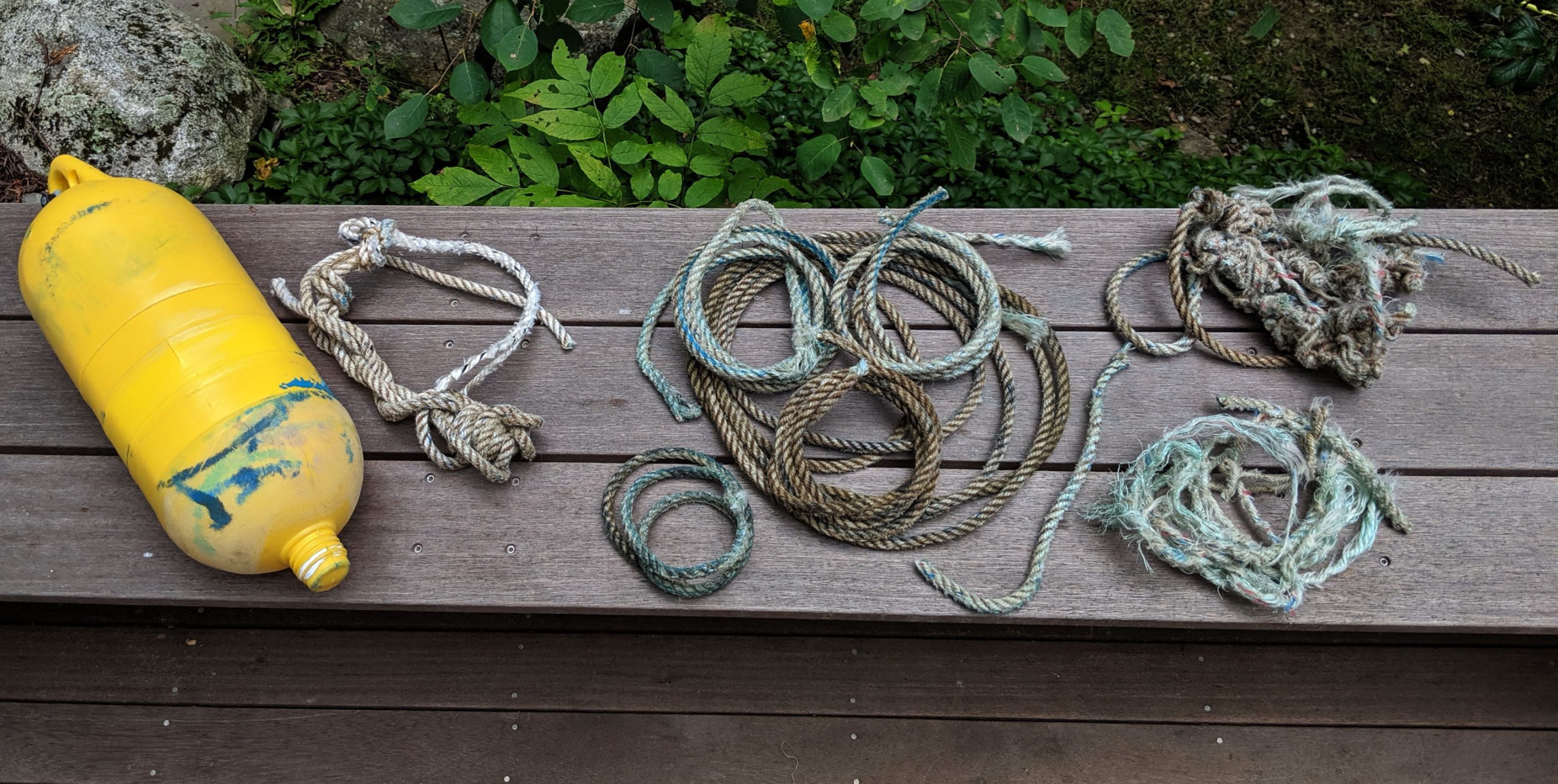
At any rate, it happened fast and the results were bad. I stopped as soon as I detected the vibration and drag, but a lot of line and more had already been wound up in Gizmo’s running gear before the prop or cutter left the trap or traps to sink back to the bottom (sorry!). In fact, we couldn’t even proceed dead slow ahead without a disturbing “whack! whack! whack!” from something hitting the prop, and so I backed about a half-mile into Buckle Harbor because it was smoother.
Once anchored at Buckle Island, I donned wetsuit and snorkeling gear to attack the problem. And while I was able to cut away the yellow buoy and prop tangle at left above — not sure which was responsible for the “whacking” — the many tight wraps and loops smothering the cutter area were beyond my abilities to take deep breathes, flipper my way to the tangle, and make a little headway with serrated blades or snippers…and then do it all over again.
A younger, fitter person might well have gotten the job done; heck, it was sunny, calm day and Gizmo has a swim platform ladder along with a hot shower head in the cockpit. But not me. So while we did continue our trip home the next day without whacking, we had to keep the RPMs below 1,200 due to vibration and I worried about the notion that tight line wraps can damage a cutlass bearing.
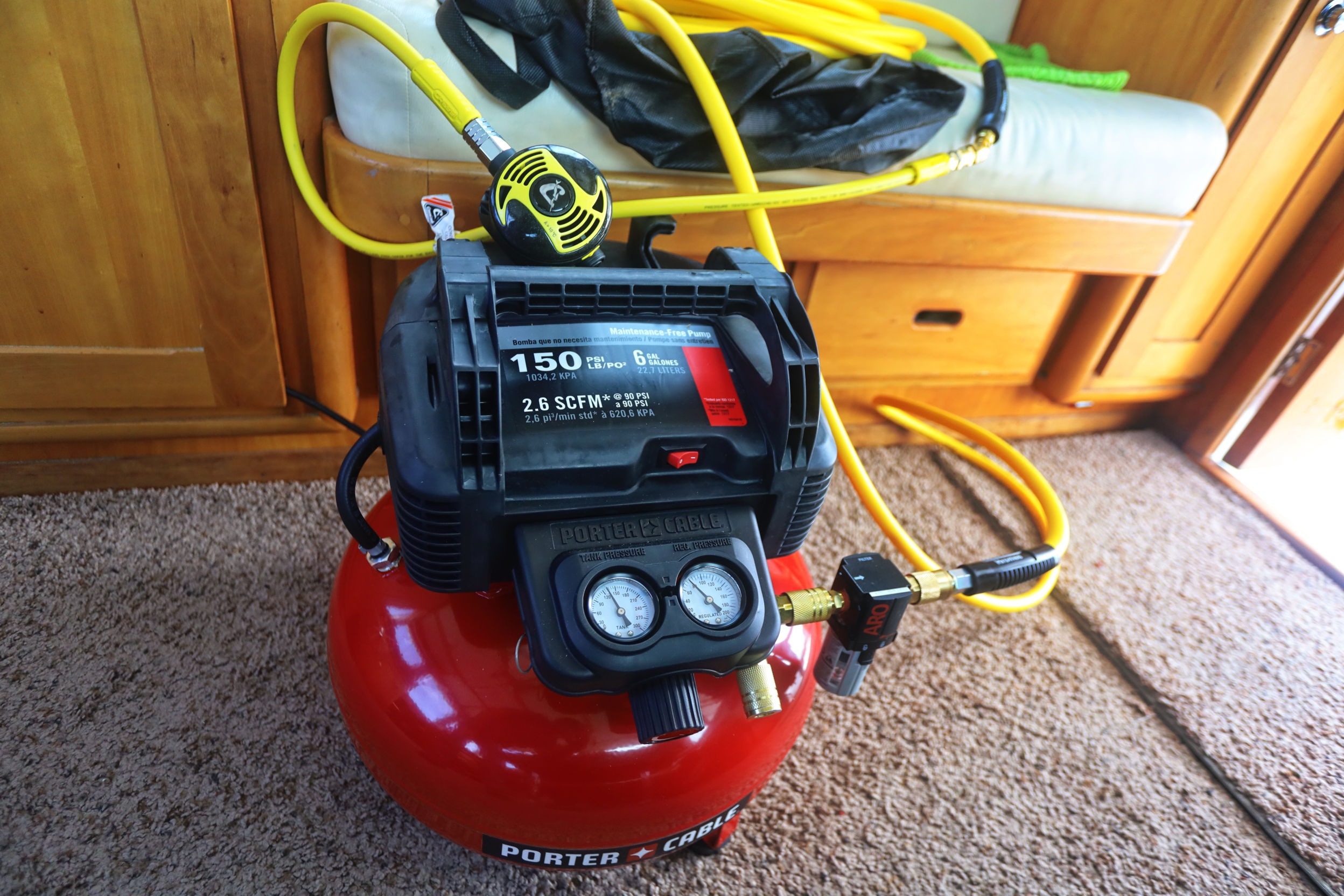
While it might have been quite hard to get a professional diver to clear the wheel out in the islands, that was an easy option in Camden. Except that I was determined to better equip Gizmo for future severe trap tangles and this was the chance to test a solution at my home float.
At first I was thinking of a compact mini scuba rig, like the Mantus Marine system, but then realized that filling the tank would be (understandably) difficult without proper certification. But I have been snorkel diving since I was 12, with a lot of grouper and conch hunting time in the 70’s, so why not a “hookah” style surface supplied system?
I researched online — highlights are this tech explainer and this how-to-DIY video — and determined that regular shop compressor could work fine. And I couldn’t find a better option than the well-proven Porter-Cable model PCFP12234, mainly because it’s only $199 with three included air tools that will be useful in my home shop. Aside for a couple of brass air hose adapters from my local hardware store, the rest came from Amazon:
- Cressi XS Octopus second stage air regulator — $80
- 50 feet Hromee Hybrid Compressor Hose — $29
- ARO F35121-400-VS Air Line Filter — $24
Note that the Hromee hose is not a quality hookah diving hose but it is PVC lined, unlike most regular air hoses, and so far I have not detected a strong taste or ill effects.
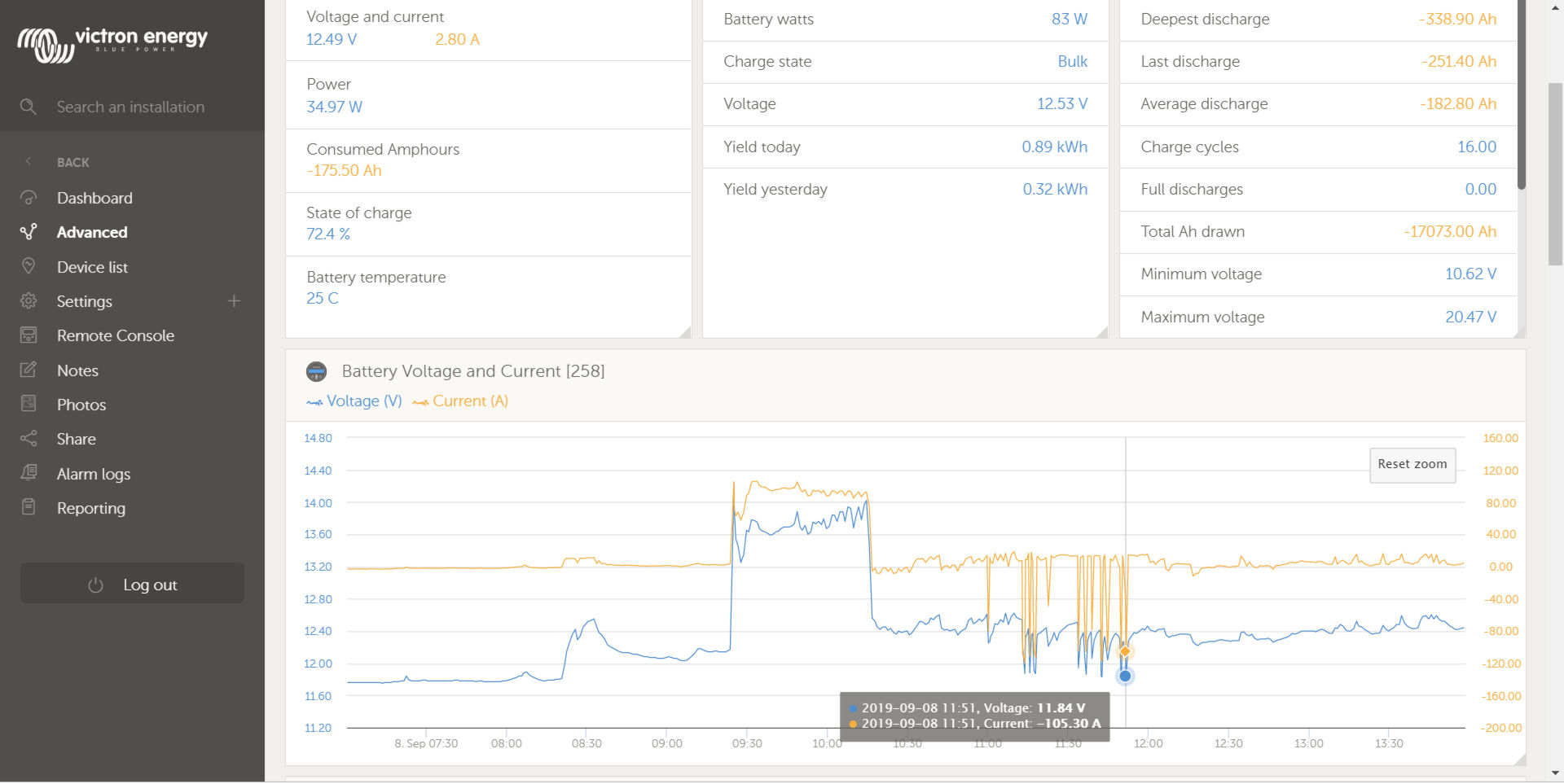
Gizmo’s 2,000 Watt Victron inverter powered the DIY hookah rig fine and you can see it intermittently drawing 100+ 12v DC amps during two mid-day dives in the Venus monitoring screen above. About 80 pounds of hose pressure felt comfortable to me, and the 150 PSI Porter Cable with its 6 gallon tank easily kept up with my underwater breathing (while my old friend Mark Abb handed down tools, took pictures, and was right there if something went wrong).

So I was quite pleased with my first surface diving experience and I’m sure the system can be a big help with fouled transducers, loose thruster nuts, and who knows what else beyond the next lobster pot tangle (I’ll work not to happen in the first place). But let me be clear that I’d get real hookah equipment if I wanted to dive deeper, or longer than maybe a few hours a year, and at my age I wouldn’t be diving under any boats if I hadn’t gotten quite comfortable with it in my youth.

But, you may ask, isn’t that compressor a lot to stow if it will rarely be used? Well, I’m thinking of leaving the Porter Cable in the shop and installing a small ultraquiet model with an aluminum storage tank in an otherwise hard-to-use space below the flybridge helm. Because then it could also easily power the serious air horn I’ve long wanted when negotiating traffic in the fog and for special occasions.
And the time is right for contemplating Gizmo projects. Notice how many antennas are stripped off in the recent photo above (and how different Camden Harbor looks). Yesterday she went into a building at Journey’s End Marine, quite ready for a systems refresh that will be interesting but much simpler than what evolved over a decade of multi-brand testing.
Update 8/28/2020: I’m pleased to report that a relatively small and inexpensive Ryobi 18v One+ cordless air compressor works fine with my hookah rig, and that includes the very real-world experience of spending time under Gizmo’s stern clearing lobster trap lines in 60-degree water. It is about as loud as the more powerful 120v AC Cable-Porter compressor I used last year, but I was also pleased that 8-10 minutes of underwater breathing hardly dented a 4 Ah battery (though I have lots of spares because I’d already learned that many Ryobi ONE+ cordless tools work well, hold up to abuse, and often go on sale at Home Depot).
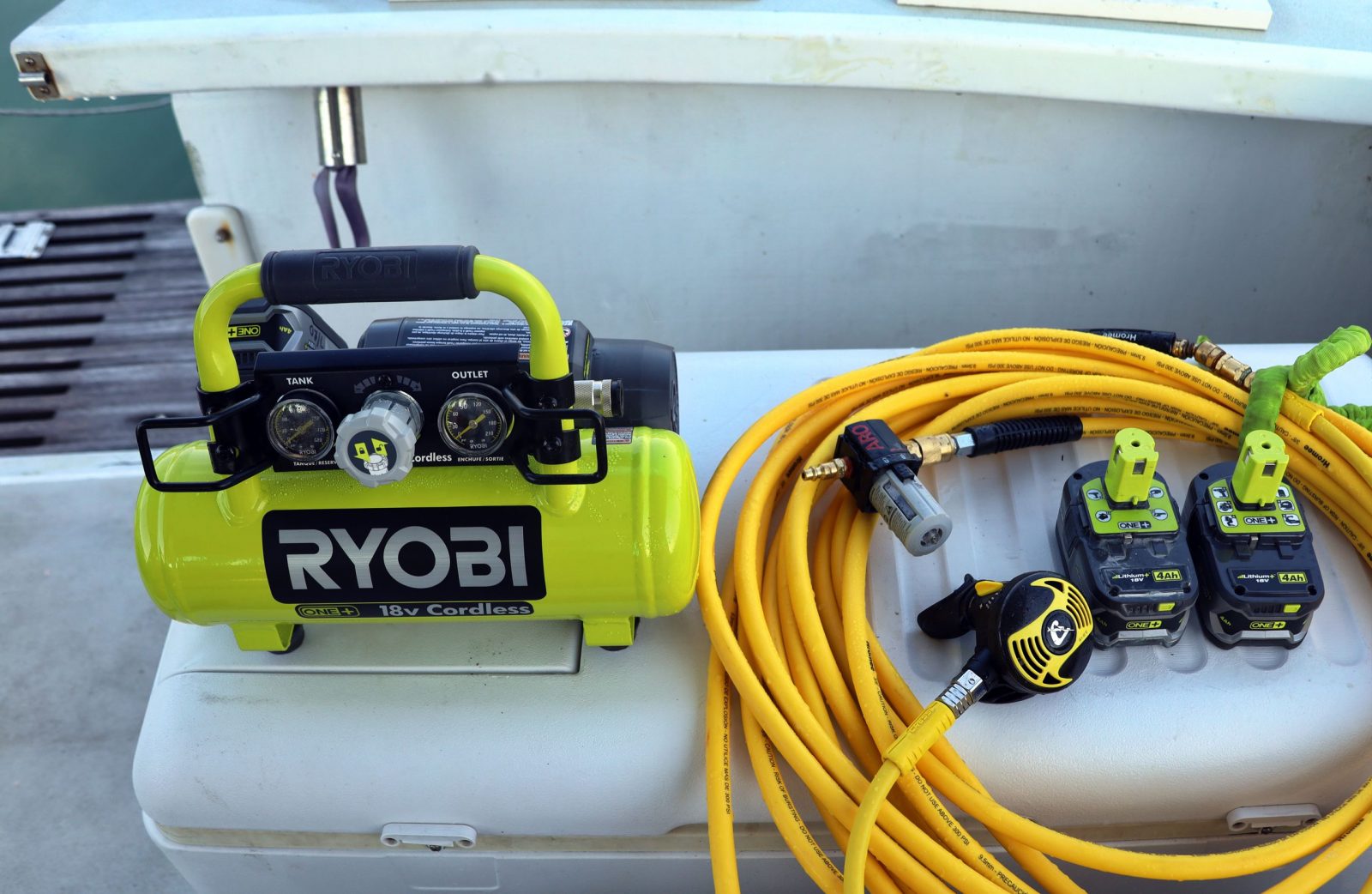




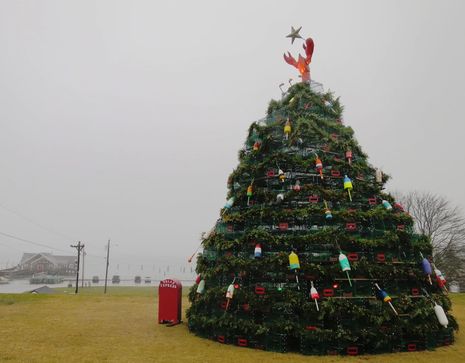
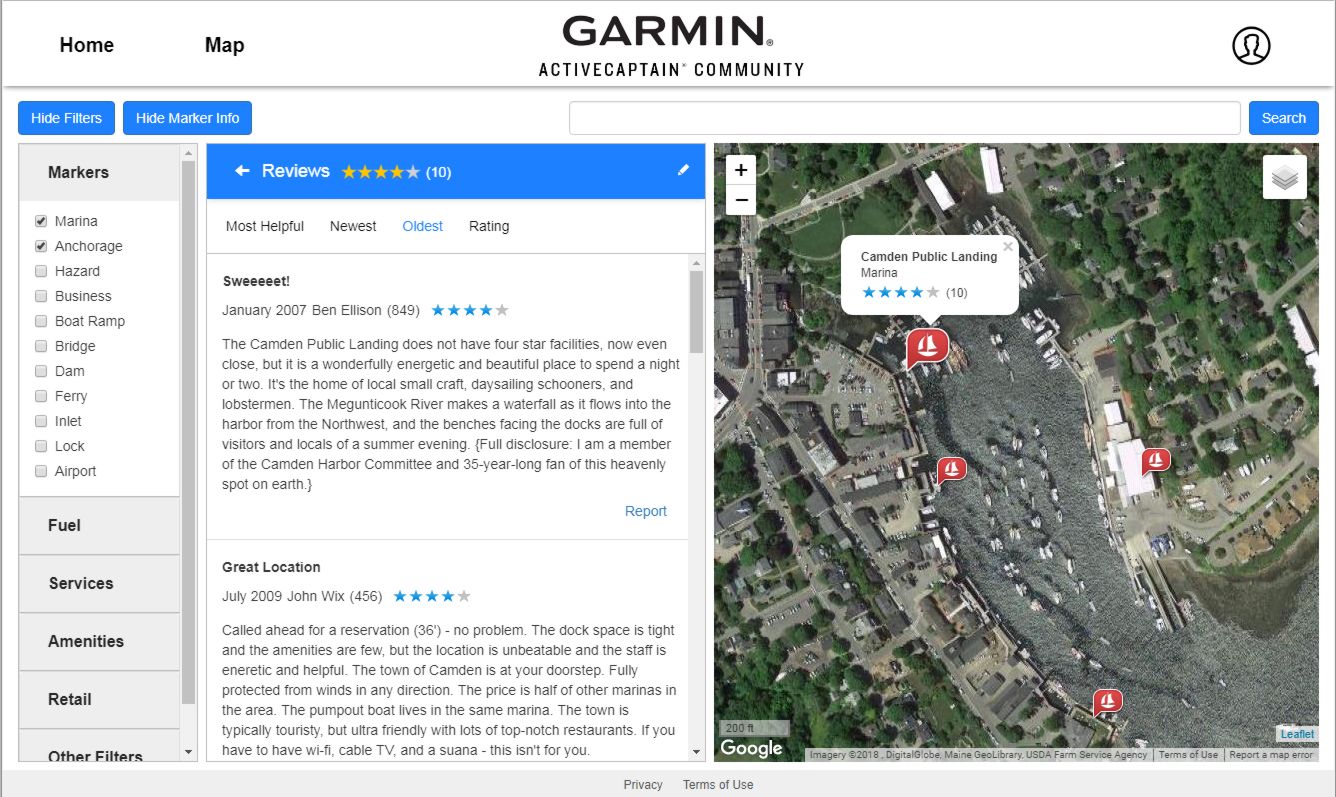







Ben’s telling me of his adventures in hookah got me thinking about options for repair dives on board Have Another Day. I’m certified so getting tanks filled isn’t an issue. And, in fact I’ve carried full dive gear with me for nearly all of my time cruising (except the one time I actually needed it which is a different story) but have decided a couple of times not to drag it all out because of the hassle factor of getting it all out of the various spots it’s stored in within the boat.
A neighbor recently showed up with a tank, long air hose and inexpensive regulator. The same day he pulled the equipment out of his car we went for a boat ride and discovered his boat couldn’t get on plane. A quick trip down with just a mask and regulator revealed significant hard growth on his props. The tank based hookah rig turned out to be the perfect tool for that job and was much less fuss than a BC, weights, tank, etc. I’m going to add a long air hose to my gear to be able to duplicate his approach.
While it does require certification the need for just a tank and no power might be the right fit for other boats. An 80 cubic foot tank at a few feet should supply hours of time under the surface.
All in all I think it’s a good idea. But 2 points. For a bit more expense you could make it a lot safer. You should get a real breathing air hose. You stated the hose you got was PVC lined. But the link you provided said ” The hose is constructed with hybrid which is blended rubber and PVC” which is quite a difference. The rubber could off gas and you don’t know if any oils where used in the manufacturing of the hose that you should not breath. .Second point is the filter you got is a 5 micron filter. A compressor that is sold for breathing air uses a 0.30 Micron HEPA inline filter. Respiratory injury can be serous.
Thanks, Ted. You’re right that I misunderstood what “hybrid” means in the Hromee hose design, and I will reconsider my cheapness in that area. I did, however, test the regular air tool hose that came with the compressor and it has a distinct taste that the Hromee does not.
As for the air filter, I took the advice of the same reasonable-sounding DIY video — https://youtu.be/pfRuQTmxKLg — that suggests getting a real diving hose. And I can’t find any HEPA filters that seem to meet your suggestion, including a search of Brownie’s Third Lung, which seems to be a top developer of surface diving gear:
https://www.browniedive.com/why-choose-a-brownies.html
Their compressor is specifically designed for diving, but it seems like they only use a particle filter with it:
https://www.browniedive.com/store/p384/In-line_Filter_Assembly.html
What am I misunderstanding and/or what could be a better filter for my rig? Thanks again.
Very pertinent information in this comment. Ben’s original article is such a grand solution especially for us older “short breath” boaters!
Sail magazine included this entry in their newsletter and it’s getting some negative feedback emails:
“Is this an oil-less compressor? Are you concerned about oil in the air fee? I thought that air supply compressors were different and the air was cleaner?”
“Yeah. Super don’t do this, or if you do, super don’t tell anyone else it’s a good idea because their widow(er) will have grounds to sue you. Mostly bad because of the high potential for inhaling toxic byproducts of hydrocarbons. Breathing air compressors use a combination of very special lubricants and very effective filters in order to produce breathable air. ”
“please resend this email with the following warning: the air compressor must be of the oil-less type. Air compressors that use oil for lubrication and cooling will give off fine oil droplets or mist in the provided compressed air and that can cause lung issues/damage if inhaled.”
Yike!
First of all, I wrote about something I’ve done, not what I think anyone else should do unless they follow the path I documented, or similar, and come to the same conclusions. Google “diy hookah diving” and enter the fray. Lots of people are apparently doing similar (including sailors) and lots of others are concerned about it, but I’ve yet to find actual documentation of harm suffered from a DIY surface breathing kit.
And, yes, the Porter Cable tool air compressor I used is oil free, as most inexpensive compressors apparently are. But there may be more than one meaning to “oil free” though I also think I can taste oil. As for hydrocarbons, I believe that’s just concern when the compressor is engine driven, not electric.
Bottom line: if you do the research and feel the least bit uncomfortable trying this, please don’t. In the meantime, I have about 45 minutes use on this kit, detect no side effects, and will (try to) report here if I ever do.
I am not an expert in this arena, but I’m a certified diver with some experience with surface air systems. I’m not seeing cause for panic. The reminder the compressor should be of an oil-less design is a good one and I think Ted is right that using a hose rated for breathing is a good idea. I’m not aware of any greater filtering than the 5 micron type mention already and it looks like that’s what others are finding as well.
I’ve seen a lot of divers using surface supplied air in marinas for bottom cleaning and zinc work. From what I’ve observed that’s split about 50-50 between using a tank and long hose and a compressor. The tank does have the benefit of not drawing air from around you, so if there’s an engine running you won’t draw that air into the compressor.
But, the other half of the divers I’ve seen all use compressors and these seem to range from tool compressors repurposed for breathing to purpose built breathing air systems. My conversations with a few of the divers indicates they haven’t seen much difference between the higher dollar purpose built units and the cheaper general purpose models. The man difference most of them noted was cost and noise.
I’ve also observed that the sellers of hookah style units are frequently very vague about what might make them different from other compressor. That’s always caused me to wonder what differences, if any, exist.
If there are major differences, I for one would love to hear them articulated. But, I suspect for occasional work on the boat this system is quite adequate, especially if that hybrid hose is replaced. And I definitely don’t think it’s a “Super don’t do this” sort of affair.
-Ben S.
I realized I forgot to mention that personally I’m made much more nervous by the systems that rely on a small gasoline motor to power the compressor. I realize care is taken to separate the exhaust and intakes but the proximity makes me uncomfortable.
Ben, I meant to respond to your comment about the filters. The spec I referenced was from a compressor for breathing air used for commercial paint spraying and sandblasting. So covered by a standard. And as a diver who has looked into filling my own tanks it made sense. But after you said you couldn’t find a filter that fine I tried. The only one I could find was one to bolt to that compressor. It went on the air intake. I did see that many of the diving line systems use a simple 5 micron filter. And I agree with you that the Porter cable compressor is oil less. It may have oil used in the manufacture but there is no oil fill. I have one.
I use the Puma brand. Have a 1.5hp 115vac and a 1hp 12vdc. Both 2 gallon. I bought the regulators and hose from gator gill. Have 25 foot hose with splitter on end of it. Dual 75 foot hoses. Have had it down to about 25 feet with one person. Works great. Have the hepa filters. We’re a pain to find, got them from a dental supply company if I recall correctly! You can find the 12vdc unit on sale and eBay sometimes less than 200.
Hey I just wanted to let you know that gator gill and puma air compressors are the same. Gator gill’ s air fittings and air filters are the same !!! Also with hookah max they use a 12 volt truck compressor as well. I just wanted to inform you thats all. Also gator gill’s electric air compressor is a California air tools air compressor as well. Ain’t like he’s manufacturing all of his compressors by hand. he’s just buying other compressors at a low discount price and making a high profit off of them. I have nothing against the guy but damn lol. Have a good day and safe dives in the water!!! Like Mel Fisher use to say , Today’s The Day!!!!!
Well, I’ve seen many products that looked the same but one was actually somewhat modified for a special purpose, like enduring the marine environment.
http://www.gatorgillunit.com/diving-packages—prices.html
http://pumaairusa.com/
https://www.californiaairtools.com/
Also interesting that Gator Gill seems to be using the same Cressi XS regulator I have, and a 40 micron filter.
Thx, Ben. This is one of the neatest solutions to a question I’ve been puzzling over for a long time. Even in a short Maine season I can certainly see justifiable value in having the same compressor I use on my Swan’s Island roofing project (and just about everything else) to save myself when cutting warp free from prop. One of the other benefits is saving yourself from working in compromised cold and current. I sliced a thumb when I finally got the sharp-enough knife going when I was already tired. Holding on with left hand in current leaving little Green’s Island cove and sawing away with right easily slipped onto thumb. Had I not been also holding my breath I never would have allowed such marginally safe working conditions. Can’t wait to try this, with the upgraded hose.
At least our waters are fairly shark free 😉
Also, I just realized that there are some cordless compressors that could power surface diving:
https://toolguyd.com/best-cordless-air-compressors/
Unfortunately, while I’m happy with my collection of 18v Ryobi tools, I don’t think that little compressor is up to the task. But here’s hoping for a 40v Ryobi compressor (with serious power like my lawnmower, leaf blower, and chain saw). Cordless has gotten great.
Ouch! Talk about adding injury to insult.
Hookah or not, Might be be a good idea for everyone to add a pair of “cut resistant” gloves to their prop clearing kit. ;-0
Thanks, Mic, I should have mentioned that, and especially with a sharp serrated shaft cutter in the mix. These are the Kevlar gloves I’m wearing in the top photo:
https://amzn.to/39geP9q
So, wow, my hookah rig works fine with a Ryobi cordless compressor that shares batteries with any of the One+ cordless tools that might also be useful on your boat. Details in the entry update above.
Seems to me you work in the wrong end of the problem, Are cages that much of a problem?
I don’t even see many lobster boats with prop cages anymore, John. I think they’re quite hard on performance, and if you do catch a pot — usually when backing down — the mess is compounded.
Hi Ben, I’m doing a Hawaii trip soon since they’ve opened back up without the 2-week quarantine. I bought the same Ryobi 18v compressor you have after reading your page. Have you tested comfortable depths with it yet? I’m hoping it would make the 30ft Brownie advertises, and I don’t plan on doing deeper than that. Unfortunately, now that it’s pretty much winter, I can’t make the cold swimming pools or lakes to test it. Thanks!
Hi Brandon, the whole idea of my rig is to only use it at the shallow depths needed to work around a boat’s bottom, i.e. surface diving. The Ryobi 18v 1 gallon cordless worked for that the one time I’ve used it, but it definitely doesn’t have the power or the air reserve that the 120v 6 gallon compressor did. I doubt it will work well at 30 feet and think you should consider hookah gear designed for real diving. Please be careful.
Thanks for the response, Ben. I definitely understand the safety aspects and wouldn’t jump into anything without a ton of research and hookah dive training first. I was really just curious how deep you’re tested it. By the numbers on the Ryobi, it looked like it could maybe handle it. The Brownie’s sea lion system is a small, .75hp compressor they advertise supporting 2 divers at 70ft deep. And the Blu3 Nemo is an even smaller custom compressor compared to the .6hp of the Ryobi. But i couldnt find air delivery cfm numbers on the commercial ones. If I try it, I would definitely stick to the surface for days and very gradually work a little deeper. Thanks!
Thanks, Brandon, and sorry I was snappy. You clearly know what you’re up to, but I’ve already been yelled at for endangering people (see 11/14/19 comment above). Please let us know how your rig works. The Ryobi 18v is certainly easy to carry and stow (and I recently realized that it might also come in handy for blowing a clog through a boat head’s joker valve ;-.)
Hi Ben , would love to hear off any updates to you rsystem, or further performance results? I made a simple 150l/m hookah , no tank, , but am keen to try this, as I really think the little tank helps.
Tristan, many have built these using aquarium air pumps without air tanks and it will work, but if you are running 12volt then it runs nonstop wasting juice when it can auto shutoff when tank is pressurized. The reason you want a tank is in the event that your motor dies and you are instantly out of air without it. The tank leaves you a little something.
Thanks Shaun , all that makes sense.
How many minutes of breathing time did the Ryobi 4amp batter provide? You mentioned 8 to 10 minutes?
Sorry, Robert, I didn’t launch my big boat last summer, so I’ve only tried using the Ryobi in the water that one time in 2020. But it provided enough air pressure to work a few feet under the stern in cold water for about 10 minutes and the battery was at 3 of 4 bars when I got out.
I’m pretty confident that the Ryobi will work fine for hookah work if needed this year, and I’ve also acquired some fittings so that I could try using compressed air to blow out a head joker valve obstruction. But that’s highly experimental and could “backfire” badly 😉
Thank you for sharing this useful information Ben! I just ordered some parts for my first Hookah approach and therefore always take care, pumps or compressor are oil free. Since I owe a lot of Ryobi tools including the mentioned compressor, I am keen of trying it. I could not find any information about the oily part but for shure, on my version is a sticker that is explained with the following in the manual: Risk to Breathing – Air obtained directly from the air compressor should never be used to supply air for human consumption.
Well – I smoke but hear also bad things about breathing oil – is this topic overrated? Does anybody find more info about this particular compressor? Thank you all again – stay healthy!
Thanks, Ben Ellison, for this information on building a Hookah system for the purpose of boat cleaning. I am gathering the components to do something similar. (I’m open water certified, BTW.) I already have the compressor (California Air Tools model 2010A) and the hose (Brownie’s Kayak Kit (40′ version). I am about to buy a second stage regulator (Hanperal 145) and a 5 micron air filter (ARO F35121-400-VS).
I had reservations about going so cheap on the regulator but I read a review from someone who: was using it for Hookah purposes, explained that is was easy to adjust for Hookah purposes, and seemed to like it. I can always switch to a Cressi (like yours) if that i need to later.
I think my biggest remaining reservation is the air filter. Like you, I searched and searched but could not find anything that would work better (than yours) that didn’t cost more than the entire rig. The air filters I looked at from the major Hookah distributors and manufacturers (especially the in-line versions) appear to use the same elements (filter elements) as those used for spray painting. I’m going with the one you picked because I see that I can buy replacement 5 micron elements for it. My biggest concern with using an “air tool” filter element is the quality of construction of the element and the associated possibility of element media migration. My reason for writing all this is to appeal to you and the others reading this thread to not give up the search for a better (but still affordable) Hookah rig Air Filter.
Thanks, again for your help.
Thanks so much for this (as usual) incredibly thorough information — I’m so appreciative of all of the insight you share on Panbo.
I would love your thoughts on the viability of using the Atmos Air station as a source for a hookah (https://www.scanstrut.com/air/atmos). It only reaches 20psi which may be the limiting factor — but I love the idea of having the air source permanently installed, and multi-function, vs stowing another piece of equipment.
Thanks in advance your perspective!
-Chris
Thanks, Chris, but while Scanstrut’s Atmos is a really impressive two-stage inflator for boats, it’s not meant to be an air tool compressor like the ones I tried for shallow water Hookah use. The pressure specifications, controls, and use cases are too different, I’m pretty sure.